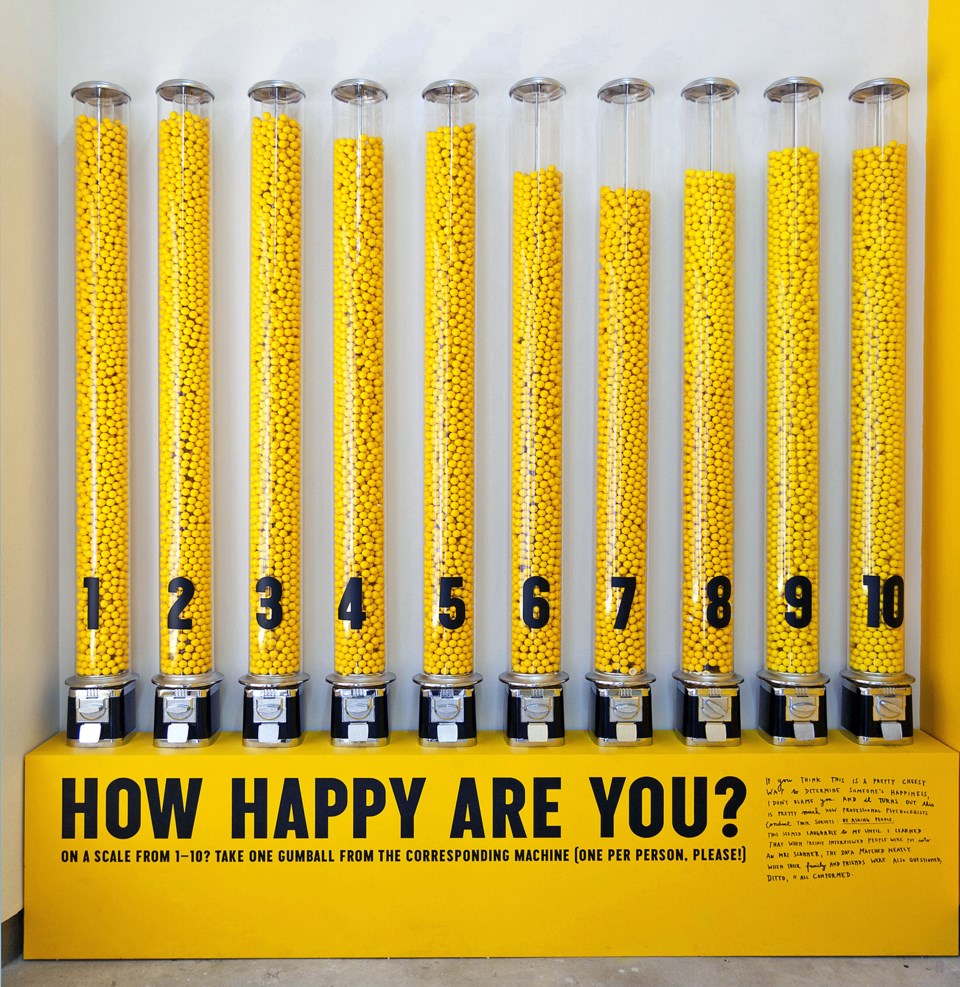Vancouver is known for a lot of things – beaches, pot, yoga pants, rain – but happiness isn’t one of them.
We’re a thoroughly unhappy population, according to recently released census results from StatsCan that ranked Vancouver last in Canada in terms of life satisfaction.
The internet is rife with theories as to why Vancouverites are so unhappy – feel free to send your own to our Rant/Rave section ([email protected]) – but the landmark 2012 Connections and Engagement survey from the Vancouver Foundation offered a laundry list of reasons, including cost of living, tenuous neighbourhood connections, and the perception that Vancouver is a difficult city in which to make new friends.
We might be an unhappy population, but we’re not without hope. In this case, hope comes in the form of Stefan Sagmeister: The Happy Show, an immersive multimedia exhibition launching this week at the Museum of Vancouver (MOV).
Described by Forbes Magazine as “the feel-good exhibition of 2013,” The Happy Show is the brainchild of Sagmeister, a Grammy Award-winning graphic designer and typographer who’s designed album covers for Lou Reed, the Rolling Stones, OK Go, David Byrne, and Aerosmith.
The Happy Show is the result of a 10-year exploration into Sagmeister’s own happiness, and marks one of the largest exhibitions in MOV’s 120-year history.
The show blurs the boundaries between art and design while filling museum galleries, stairwells, hallways, and restrooms with infographics, video projections, and hands-on installations.
“My setup for both the film and the exhibition is, ‘Is it possible to change my mind in the same way that I can change my body?’” says Sagmeister, speaking by phone in Vancouver, having flown in from New York for the show.
Sagmeister, who has delivered popular TED talks on happiness and design, pursued three different strategies in his search for happiness: meditation; cognitive therapy; and mood-altering pharmaceuticals.
“I would say that all of these three strategies were actually effective, meaning I felt changes in all of them. At the same time, [though], I found that the direct pursuit of happiness was overall not successful for me,” he explains.
“Overall, it’s an extremely complex issue that is extremely difficult to proceed with a single-minded strategy.”
Sagmeister waded through thousands of definitions of happiness over the course of his research, and became keenly interested in those that look at the connection between happiness and length of time.
“You have things that are very short in length of time, that last maybe a few seconds, that would be more in the way of joy or bliss or possibly an orgasm, and then there are medium lengths of experience, like when you spend a Sunday afternoon with a paper at the park. And you have very long experiences, possibly lifelong, like finding the thing that you’re good for in life, fulfilling your potential,” says Sagmeister.
“These three things all fall under the giant terminology of happiness, but really have little to do with each other. If you think of an orgasm, it really has nothing to do with finding what you’re good for in life.”
Confronted with stories about wellness, mindfulness, and sex, visitors to The Happy Show will be immersed in an experience akin to walking into Sagmeister’s mind.
There’s a stationary bike that powers a wall of neon; a giant inflatable monkey; a series of gumball machines that display visitors’ collective level of happiness; and a preview of Sagmeister’s soon-to-be-released documentary, The Happy Film.
Sagmeister will deliver a lecture on happiness on April 23. Throughout the summer, MOV will host a series of Happy Hours exploring happiness in politics, design, bikes and beers, money, and urban life. W
• The Happy Show runs until Sept. 7. For details, visit MuseumofVancouver.ca


